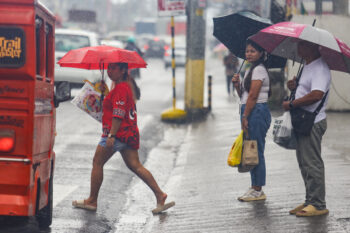 AFTERMATH. A resident shovels mud out of his house, a day after the Davao River spilled and flooded Awhag Village in Bacaca Road, Davao City on Jan. 21, 2012. The flood forced the evacuation of at least 2,000 families living beside the river. MindaNews photo by BJ Patino
AFTERMATH. A resident shovels mud out of his house, a day after the Davao River spilled and flooded Awhag Village in Bacaca Road, Davao City on Jan. 21, 2012. The flood forced the evacuation of at least 2,000 families living beside the river. MindaNews photo by BJ Patino
DAVAO CITY (MindaNews/22 January) – The floods in Davao City had forced a total of 14,352 families or 43,218 individuals to evacuate as of 8:00 a.m. Tuesday, according to the City Social Services and Development Office (CSSDO).
Public schools, gymnasiums, barangay halls and chapels have been used as temporary shelters for the displaced victims, said CSSDO head Ma. Luisa Bermudo.
Lasang, Davao, Lipadas and Talomo Rivers overflowed Saturday, affecting 15 villages here since Sunday dawn.
The 15 flood-stricken barangays — Tigatto, Waan, Mandug, 19-B, 1-A, 5-A, 8-A, 9-A, 10-A, 2-A, 74-A, 76-A, Maa, Lasang, and Calinan — were placed under a state of calamity. The city has 182 barangays.
City Mayor Sara Duterte called the floods “an act of God” that can’t be avoided.
She said the rivers could no longer hold excessive rainwater coming from the highlands.
“The city has been prepared for flooding but the frequency of flooding cannot be predicted,” Robert Alabado III, chief of the City Planning and Development Office (CPDO), said.
He said the disaster was a natural occurrence, a result of the wet season that started in December yet.
Subdivisions near rivers such as Gem Village in Maa, Riverside Village in Bucana, El Rio Subdivision in Bacaca and new subdivisions in Tigatto are prone to flooding, he added.
The CPDO had advised residents to make their structures flood-ready.
Alabado noted that most residents in Matina Pangi had heeded their advice by making their houses at least two-storey high.
“[But] this is only a temporary reduction of risks as the best way for them to do is to avoid establishing houses in flood-prone areas and prepare for the worse,” he emphasized.
Davao had organized disaster risk reduction groups in every village which have undergone drills on how to move residents away from danger zones, Emmanuel Jaldon, chief of the City Disaster Risk Reduction and Management Council (CDRRMC), said in an earlier interview.
Meanwhile, the local government had also integrated disaster risk reduction and management measures in its Comprehensive Development Plan for 2012-2021.
The zoning committee of the city council had also proposed updating its zoning ordinance. (Lorie Ann Cascaro/MindaNews)
